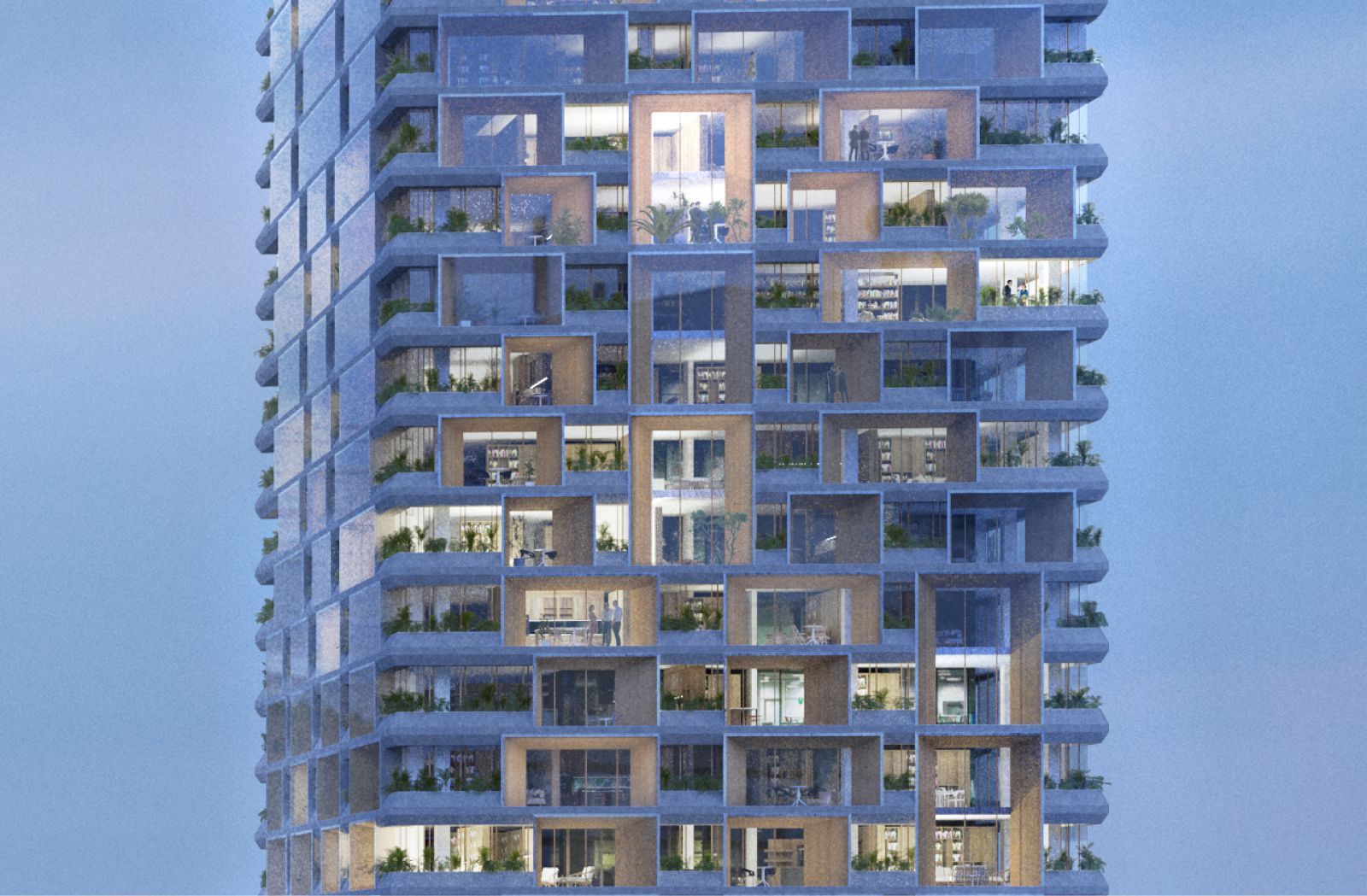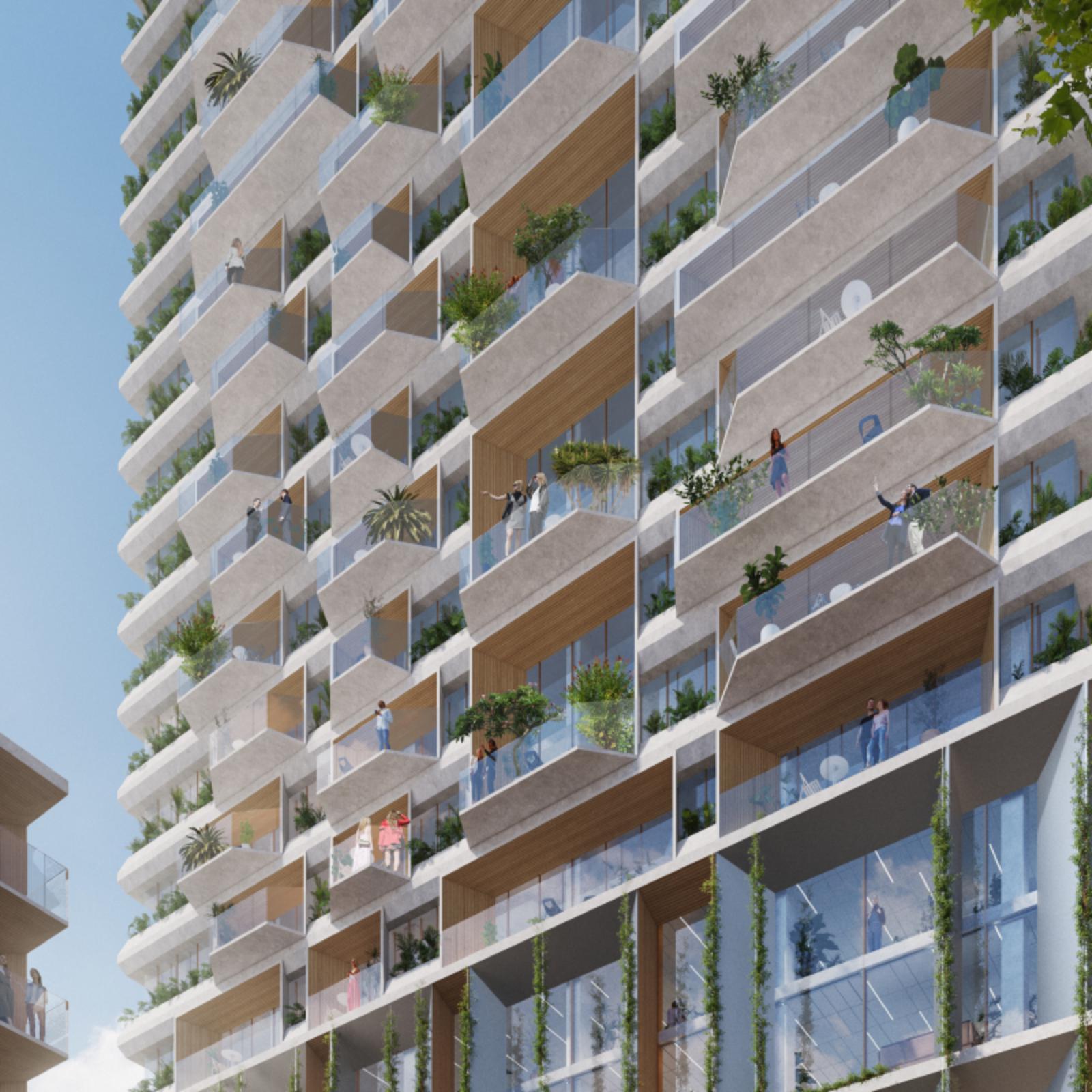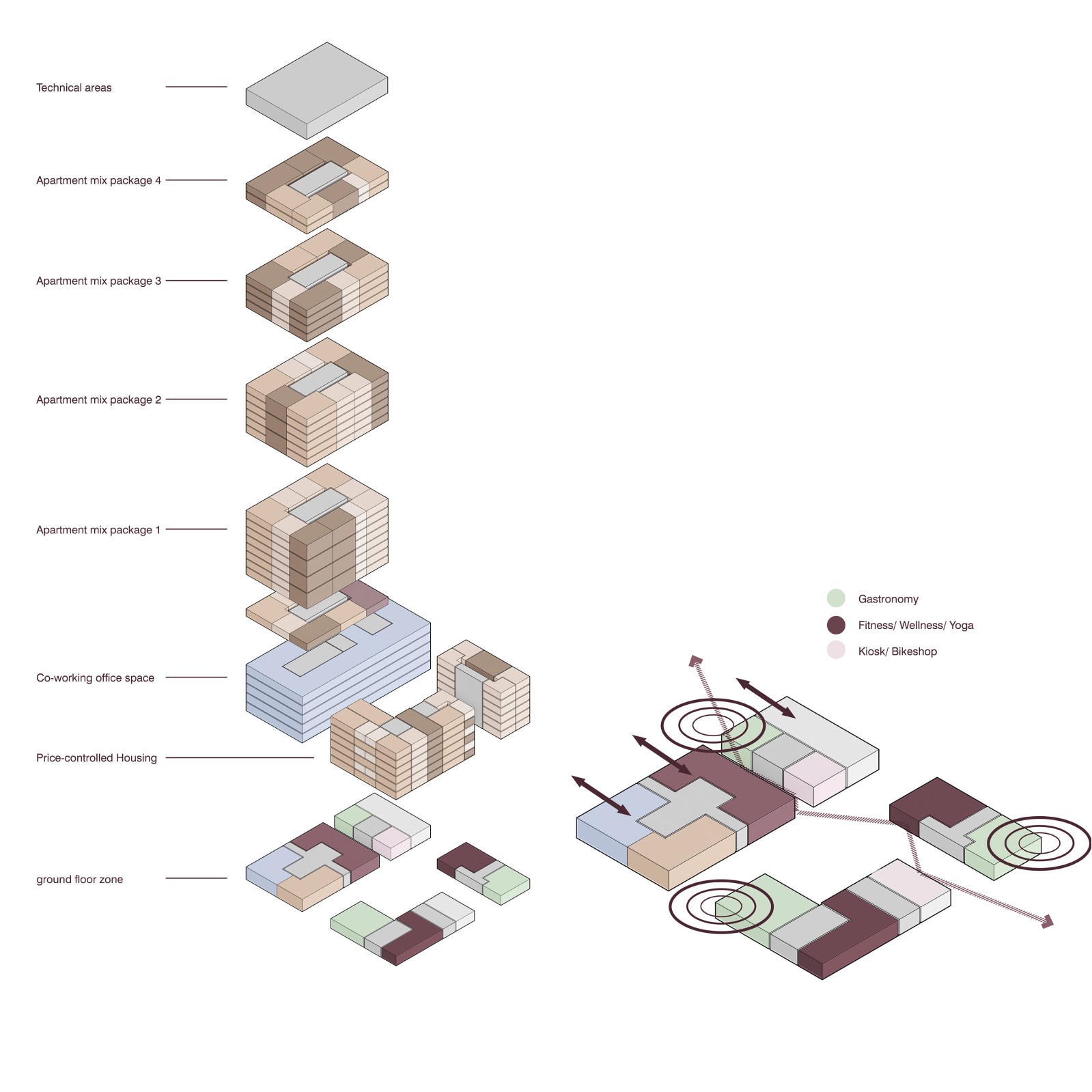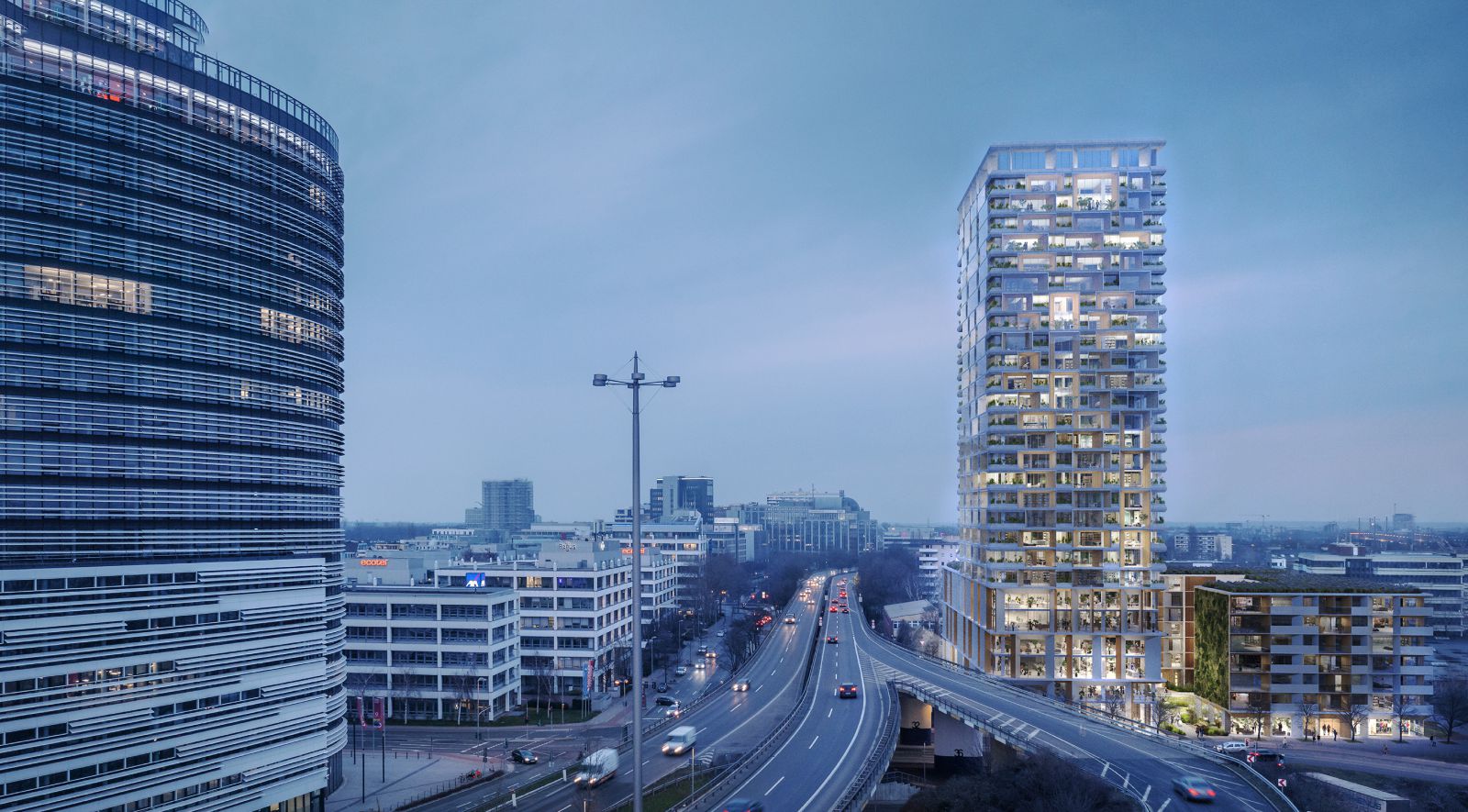Cologne-based project developer PANDION recently held an international architectural competition for a new mixed-use high-rise building in Düsseldorf. The design by UNStudio and OKRA Landscape Architects was chosen by the jury as the winning design by majority vote. The approximately 90 meter tall building will be located at the entrance of the city, culminating at the Belsenpark masterplan urban development in the district of Oberkassel, on the left bank of the river Rhine.
The Belsenpark tower, which will stand on the perimeter of the masterplan, is designed and positioned to fit the grain of the surrounding developments, in addition to connecting nearby communities. The positioning of two additional low-rise buildings forms an intimate pocket park surrounded by public uses. A programmed pedestrian axis that runs from underneath the nearby elevated road, through the building and into the courtyard park, ensures permeability and connectivity for pedestrians and cyclists.

A varied and porous programme in the ground floor zone, which includes the open park area, gastronomy outlets and a health, sport and wellness programme, will encourage social interaction for the residents and the surrounding community. The mixed-use tower will house offices on the lower levels and a rich mix of apartment types above. The two low-rise buildings comprise cost-controlled housing.
Ben van Berkel: “The very varied apartment mix, with the addition of the cost-controlled housing, will not only enable the social integration of different demographics, it will also provide much needed housing as the city continues to densify.” Below the seventh floor, the residential high-rise merges into flexibly designed co-working office spaces. The dimensions of the floor plan are ideal for creating flexible office spaces comprising a mix of cell structures and contemporary work environments.

This part of the tower also acts as a sound barrier for the inner courtyard and residential development behind. The articulation of the tower is designed to fit within its surrounding context while expressing the different scales and the liveliness of the building’s different uses. Each of the facades is designed to respond to noise pollution, views, daylight and sunlight levels. Due to the comparatively low noise levels on the side facing the park, open balconies with all-glass balustrades provide unobstructed views.
The office spaces on the lower levels denote generous pixel-like structures that refine upwards accross the varied residential programme and visually bind the programme within the tower. The apartments are modular, with small and large units flexibly mixed and organised into packages. The apartment sizes range from 30 square metres to 130 square metres. Across the residential facades a variety of textures is created by a play between loggias and bay windows that also incorporate biophilia and echo the rhythm of the apartment mix.

Sound insulation
One side of the Belsenpark tower faces a busy elevated road junction, a source of high level noise pollution. Despite this, all of the apartments in the tower have an outdoor area. On the sides of the building facing the street, the apartments have loggias which are enclosed by sound-reducing baffle panes. The surrounding noise is further reduced both by a ventilation gap in the baffle pane and by sound-absorbing wooden linings inside the loggia.
The geometric alignment of the deep soffits in the facade elements also offer a high level of soundproofing and passive sun protection, while maximising the view of the Rhine floodplains. On the lower area of the building, slightly iridescent light aluminum elements and white plaster facades of the price-controlled living programme reflect the materiality of the context, while light natural stone elements characterise the appearance of the tower next to the warm wood-clad loggias.

Landscape planning
Belsenpark is strategically located in one of Dusseldorf’s east-west green corridors. These landscape corridors have the potential to extend further west and strengthen the city’s greenery and bio-diversity. The location of the project therefore forms a critical green link within this network, supporting new bio-diversity on a larger scale, while physically connecting various smaller green facilities at a neighborhood level. The landscape planning of the development also forms an integral part of the architecture.
The geometric patterns of the building facades are reflected in the landscape plan, creating seating niches along the main development and emphasising the entrances. At the intersection of the two cycle and pedestrian paths, a water feature creates an attractive place to enjoy the sun, while supporting a sustainable approach to water management.

Circularity and water management
The integrated rainwater approach combines green components with sustainable water management tools to create a green-blue system that can buffer rainwater. Rainwater is captured on the green roofs via a water retention layer, while the overflow is directed to the planting in the pocket park.
The overflow of this water, in addition to all runoff from the hard surfaces in the park, is directed to the main water feature via visible gutters. This location can also be used as a detention basin during extreme flooding, providing a strategy for a circular water system. The water feature is gradually channelled into a rainwater tank and reused for watering plants during dry periods.

Sustainability
In addition to using prefabricated components in construction and taking a modular approach to the supporting structure, facade and building services, the aim is to significantly reduce CO2 emissions during operations. Modular planning simplifies the process, while focus is placed on resourcing when choosing the construction approach and materials for the design. As such, particular attention is paid on the concept of reducing CO2 in construction and operation and to avoiding waste by up-cycling materials.
Both the supporting structure and the facade layout follow a stringent grid. This modular approach enables maximum flexibility for extension and facade design. Whilst wood is proposed for the load bearing components of the low-rise buildings, the tower will be constructed using reinforced pre-fab recycled concrete and CO2-reduced cement. Ideally, local aggregates will also be used in combination to minimise energy-intensive transport routes. Source by UNStudio.


- Location: Düsseldorf, Germany
- Architect: UNStudio
- Design Team: Ben van Berkel with Tina Kortmann and Stelina Tsifti, Carolina Bocella, Ignacio Andres Mejia Zubillaga, Dichao Wang, Zhongming Fang, Verena Lihl, Stijn Tonen, Jan Schellhoff
- Landscape: OKRA landschapsarchitekten
- Structure and Facade: Bollinger+Grohmann
- MEP and Energy: KBP Ingenieure
- Fire: HHPberlin
- Developer / Client: PANDION
- Year: 2022
- Images: Flying Architecture, Courtesy of UNStudio

